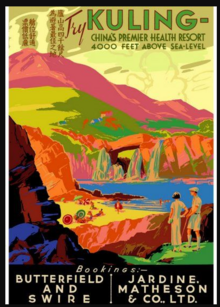Guling, Jiangxi
Guling
牯岭镇 | |
|---|---|
Town | |
 | |
| Coordinates: 29°34′13″N 115°58′36″E / 29.57028°N 115.97667°ECoordinates: 29°34′13″N 115°58′36″E / 29.57028°N 115.97667°E | |
| Country | China |
| Location | Mountain Lu, Jiujiang |
| Founded by | , and three others |
| Time zone | UTC+8 (China Standard) |


Guling (Chinese: 牯岭), postal romanization Kuling, is a resort town located on top of Mountain Lu, Jiujiang, China.[1] It is the tourist and administration center in the Mountain Lu National Park, a World Heritage Site.[2]
As of 2018, it has 5 residential communities, 2 villages, and 4 other neighborhoods under its administration.[3]
History[]
European Settlement History[]
Guling, also called Kuling, on the slopes of a wide valley of Mountain Lu, was established in 1895 by the missionaries Dr. Edgerton Haskell Hart and three others, as a sanitarium and rest resort for Western missionaries in southern China. They built their houses in the colonial style of architecture, and added churches, schools, and sports facilities. It was named by Little, as a pun: it is wonderfully cooling after the summer heat in the plains below. It was also a word that sounded conveniently Chinese to the local people, and has been adopted by them. Kuling was run by the missionaries in a Kuling Council that sold the plots of the land and with the proceeds paid for local services and security. In 1910, Caroline Maddock Hart and four others met to found the Nurses Association of China; with Caroline Maddock Hart being its first president.
The Republic of China History[]
1934, Soong Mei-ling, then first Lady of the Republic of China, was given a villa in Kuling town, Mountain Lu. She and her husband Chiang Kai-shek both love the villa very much. Chiang Kai-shek named the villa as Mei Lu Villa to symbolize the beauty of Mountain Lu. The couple usually stay at this villa in Kuling town, Mountain Lu in summer time, so the mountain is called Summer Capital, and the villa is called the Summer Palace.[4][5][6]
Prior to 1949, President Chiang Kai-shek chose Mountain Lu as the summer headquarters for his nationalist Kuomintang government, having been introduced to the place by his wife Soong Mei-ling, the daughter of a Shanghai Methodist minister. It was here that in 1946 the U.S. special diplomatic mission representing the President of the United States led by General George C. Marshall met with Chiang Kai-shek to discuss the role of post-World War II China.
Modern History[]
After the communist revolution in China in 1949, it became favourite meeting place for the Central Committee of the Communist Party of China because Chairman Mao used Chiang Kai-shek's house as one of his holiday homes. It hosted the Eighth Plenum of the Eighth Central Committee, also known as the Lushan Conference or "Plenum", which began on 23 July and convened on 2 August, 1959. Guling also hosted the Second Plenum of the Ninth Central Committee in August 1970.
The movie Romance on Mountain Lu, which has been shown in the Lushan theatre non-stop since 1980, was recognised by Guinness World Records as the longest running movie in theatres. Each ticket sold to this movie is numbered according to ticket sales to date. As of May 2006, this number is close to 140 million tickets.[citation needed]
Notable Residents[]
- Pearl S. Buck (1892-1973), was the first American woman to win the Nobel Prize in Literature, for her rich and truly epic descriptions of peasant life in China, in 1938. She also won the Pulitzer Prize in 1932. She spent her childhood with her family in Kuling town in summer time. Her father built a stone villa in Kuling town in 1897, and lived there until his death in 1931.[7][8]
- Mervyn Peake (1911-1968), was born in Kuling town, Mountain Lu. He was an English writer, artist, poet, and illustrator. He was well known for being the illustrator of Alice's Adventures in Wonderland[9] and the author of the Gormenghast series of novels.
References[]
- ^ 2018年统计用区划代码和城乡划分代码:庐山市 (in Chinese). National Bureau of Statistics of the People's Republic of China. Retrieved 2019-03-08.
- ^ "Guling". Tuniu. Retrieved 10 July 2017.
- ^ 2018年统计用区划代码和城乡划分代码:牯岭镇 (in Chinese). National Bureau of Statistics of the People's Republic of China. Retrieved 2019-03-08.
- ^ WANG, N. N., & JIANG, Z. (2007). " Usingnaturalwith ingenious ways, man and naturelive in harmony"——Simplyanalysis thedesign concepts of Mount Lushan" Meilu" villa to the inspirationofmodern ecological landscape design. Hundred Schools in Arts, 03.
- ^ "Kuling American School Association - Americans Who Still Call Lushan Home". Kuling American School Association 美国学堂 Website. Retrieved 24 July 2021.
- ^ "《今日庐山之"美庐"》". 故宫博物院The Palace Museum Website. Retrieved 24 July 2021.
- ^ "赛兆祥墓碑". mylushan.com. Retrieved 22 July 2021.
- ^ "Pearl S. Buck house in Zhenjiang". Retrieved 22 July 2021.
- ^ "Alice's Adventures in Wonderland". amazon.com. Retrieved 22 July 2021.
- Lushan City
- Township-level divisions of Jiangxi
